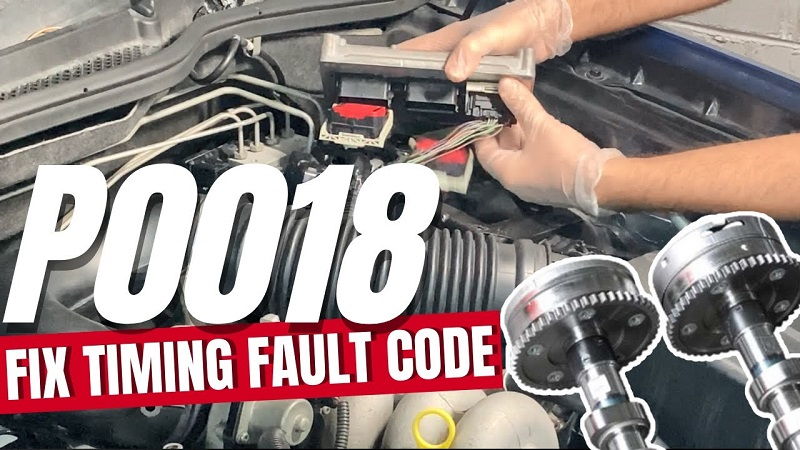This post contains affiliate links. This means I will make a commission at no extra cost to you should you click through and make a purchase [ “As an Amazon Associate, I earn from qualifying purchases.” ]. Read the full disclosure here.
Demystifying the P0018 Code: Crankshaft Position – Camshaft Position Correlation (Bank 2 Sensor A) GuideMechanic.Com In the realm of automotive diagnostics, the emergence of a fault code can be a cause for concern for vehicle owners and technicians alike.
Among the plethora of diagnostic trouble codes (DTCs) that can trigger the check engine light, the P0018 code stands out, indicating a potential issue with the correlation between the crankshaft position and the camshaft position in Bank 2 Sensor A of the engine.
Understanding the intricacies of this code, its possible causes, and the steps for diagnosis and repair is crucial for ensuring the continued functionality and reliability of the vehicle.
See Also: P0016 Code: Camshaft Position Correlation (Bank 1 Sensor A)
Deciphering the P0018 Code:

The P0018 code specifically highlights a discrepancy in timing between the crankshaft and camshaft in Bank 2 Sensor A of the engine.
In modern vehicles equipped with sophisticated engine management systems, precise synchronization between these components is imperative for optimal engine performance, fuel efficiency, and emission control.
When the Engine Control Module (ECM) detects a deviation beyond acceptable limits in the timing correlation between the crankshaft and camshaft, it triggers the P0018 code and prompts the illumination of the check engine light on the dashboard.
Potential Causes of the Code:
Faulty Camshaft or Crankshaft Position Sensor:
Check out this Hitachi CPS0006 Engine Crankshaft Position Sensor, Multicolor

Malfunctioning sensors can provide erroneous data to the ECM, leading to timing discrepancies and the activation of the P0018 code.
Timing Chain/Belt Issues:
Worn or stretched timing chains or belts in Bank 2 can introduce slack, disrupting the timing relationship between the crankshaft and camshaft.
VVT Solenoid Malfunction:
The Variable Valve Timing (VVT) solenoid controls oil flow to adjust camshaft timing. If it fails or becomes obstructed, timing issues may arise, triggering the P0018 code.
Engine Oil Problems:
Insufficient oil pressure or contaminated engine oil can impede the operation of VVT components, affecting timing synchronization and prompting the fault code.
Mechanical Engine Faults:
Damage to components such as timing chain guides, tensioners, or gears can interfere with the timing correlation between the crankshaft and camshaft, resulting in the appearance of the P0018 code.
ECM Malfunction:
Although uncommon, a malfunctioning ECM may misinterpret sensor data, leading to incorrect timing adjustments and the activation of fault codes such as P0018.
P0018 Code Crankshaft Position – Camshaft Position Correlation (Bank 2 Sensor A)
Diagnosis and Repair:

Diagnosing the underlying cause of a P0018 code necessitates a systematic approach by a qualified automotive technician:
Code Retrieval:
Utilize a diagnostic scan tool to retrieve the trouble codes stored in the ECM, paying close attention to any accompanying codes that may provide additional insight into the issue.
Visual Inspection:
Conduct a visual inspection of engine components, focusing on the timing chain/belt, sensors, and VVT solenoid for signs of wear, damage, or oil leaks.
Sensor Testing:
Test the camshaft and crankshaft position sensors using a multimeter to ensure they are operating within specified parameters.
Oil Pressure Check:
Verify adequate engine oil pressure using a mechanical gauge, addressing any issues with oil level or viscosity that may affect VVT operation.
Timing Components Inspection:
If necessary, remove components such as the timing cover to inspect the timing chain, tensioners, and guides for wear or damage that could affect timing synchronization.
VVT System Testing:
Test the VVT solenoid for proper operation and check for obstructions in the oil passages that could impede its function.
ECM Scan:
Perform a comprehensive scan of the ECM for any potential software-related issues or updates that may resolve the problem.
P0018 Code Crankshaft Position
Once the root cause has been identified, repairs can be initiated:

Sensor Replacement: Replace any faulty camshaft or crankshaft position sensors, ensuring proper installation and calibration.
- Timing Chain/Belt Replacement: If timing components are worn or damaged, replace them following manufacturer specifications to restore proper timing synchronization.
- VVT Solenoid Replacement: Replace the VVT solenoid if it is found to be faulty, ensuring unimpeded oil flow and optimal timing adjustment.
- Oil Change and Maintenance: Perform an oil change using the manufacturer’s recommended oil grade and viscosity, addressing any oil-related issues that could affect VVT operation.
- ECM Replacement/Reprogramming: If necessary, replace or reprogram the ECM to rectify any software-related issues that may be contributing to the fault code.
Conclusion:
See Also: P0017 Code Crankshaft Position – Camshaft Position Correlation (Bank 1 Sensor B)
The appearance of a P0018 code indicating a crankshaft position – camshaft position correlation issue demands prompt attention to prevent potential engine damage and performance degradation.
Understanding the underlying causes and following a systematic diagnostic approach is essential for accurate diagnosis and effective repairs.
By addressing the root cause of the problem, vehicle owners can ensure the continued reliability and performance of their vehicle on the road.
Regular maintenance, including oil changes and inspections, can also help prevent such issues from arising in the future, ultimately extending the lifespan of engine and drivetrain components.
- Catalytic Converter Cleaner Nearby - April 25, 2025
- BMW Catalytic Converter Price: What You Need to Know - April 24, 2025
- Scrap Catalytic Converter Price - April 24, 2025
